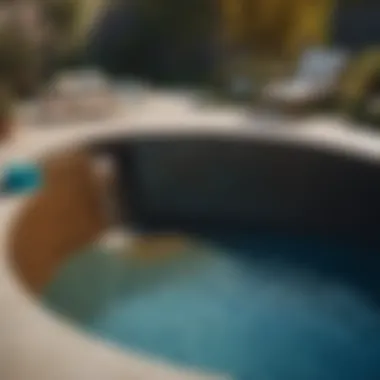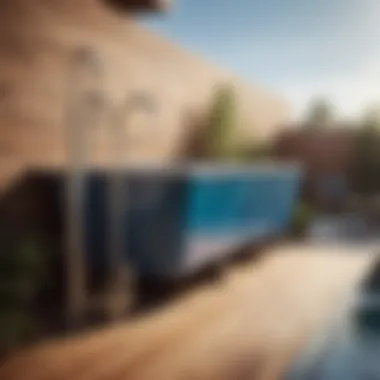Materials:
To embark on the journey of installing your own pool, you will need to gather a comprehensive list of materials. Here's a detailed breakdown of the items you'll require:
- Pool Kit: Select a pool kit that suits your space and preferences, ensuring it includes all necessary components such as walls, liner, pump, filter, and ladder.
- Surface Prep Materials: Gather materials for preparing the pool site, including sand, gravel, and leveling tools.
- Tools: Acquire essential tools like a shovel, tape measure, level, rubber mallet, and screwdriver to facilitate the installation process.
- Safety Equipment: Prioritize safety by obtaining equipment such as goggles, gloves, and sturdy footwear.
DIY Steps:
Planning:
Before diving into the installation process, carefully plan the pool's location, size, and design to ensure it aligns with your vision and local zoning regulations.
Site Preparation:


Excavate the designated area to the specified dimensions for your pool size, taking care to level the ground adequately and remove any debris or obstacles.
Assembling the Pool:


Follow the manufacturer's instructions to assemble the pool walls, secure the liner, install the pump and filter system, and set up the ladder according to the provided guidelines.
Technical Aspects:


- Timeline: Allocate sufficient time for each stage of the installation process, accounting for factors like weather conditions and the complexity of the pool kit.
- Tools: Utilize the correct tools for each task, ensuring precision and efficiency throughout the installation to achieve optimal results.
- Quality Techniques: Implement quality techniques such as proper leveling, accurate measurements, and secure fastenings to enhance the durability and aesthetics of your DIY pool.
DIY Project Process:
Sequential Steps:
-
Lay Out the Pool Kit Components: Place all components in the designated area to facilitate easy access during assembly.
-
Assemble the Walls: Start by erecting and securing the pool walls according to the manufacturer's instructions, ensuring a sturdy foundation.
-
Install the Liner: Carefully place and secure the pool liner inside the walls, smoothing out any wrinkles or air pockets for a pristine finish.
Troubleshooting Tips:
- Uneven Ground: Address any issues with uneven ground by using additional leveling materials and tools to create a stable base for the pool.
- Leak Detection: Thoroughly inspect the pool components for leaks or tears in the liner, promptly addressing any issues to prevent water loss and structural damage.
By following these meticulous instructions and incorporating precise measurements and techniques, you can embark on the journey of installing your own pool with confidence and success.
Introduction
Installing a pool on your property can be an exciting yet challenging undertaking that requires careful planning and execution. This article delves into the complexities of DIY pool installation, guiding individuals through the considerations, challenges, and steps involved in this ambitious project.
Understanding the Scope
Assessing Your Property
Assessing your property before installing a pool is a critical first step in ensuring the feasibility of the project. Understanding factors such as soil composition, drainage, and available space is essential in determining the suitability of your property for a pool. By assessing these aspects thoroughly, you can mitigate potential issues that may arise during the installation process. This detailed analysis of your property lays the foundation for a successful pool installation, highlighting key considerations that impact the overall outcome. While this step may require time and effort, it is a crucial investment in ensuring the long-term functionality and durability of your pool.
Researching Local Regulations
Researching local regulations is a vital aspect that cannot be overlooked when installing a pool. Each municipality may have specific guidelines and zoning requirements governing pool construction, including safety measures, setback distances, and permits. By understanding and adhering to these regulations, you can avoid legal disputes and ensure compliance with governing authorities. This meticulous research not only fosters a smoother installation process but also guarantees that your pool meets all necessary standards for safety and legality.
Benefits and Drawbacks
Cost Savings vs. Risks Involved
One of the primary motivations for DIY pool installation is the potential cost savings it offers compared to hiring professional contractors. By taking on the project yourself, you can save on labor costs and have more control over the budget. However, it's crucial to weigh these cost savings against the risks involved in self-installation. Challenges such as incorrect installation, warranty implications, and potential safety hazards should be carefully considered before embarking on a DIY pool project. While the prospect of saving money is attractive, understanding the risks and being prepared to address them is key to a successful outcome.
Planning and Preparation
In the realm of pool installation, proper planning and thorough preparation are paramount to the success of the project. The planning stage sets the foundation for the entire endeavor, ensuring that every aspect is meticulously considered and orchestrated. Without adequate planning and preparation, the installation process could encounter delays, errors, or even safety hazards. Embracing the Planning and Preparation phase in this article signifies a key proactive approach towards achieving a professionally executed DIY pool installation.
Design Considerations
Size and Shape Selection
Size and shape selection are crucial decisions that significantly impact the functionality and aesthetics of the pool. Addressing the specific aspect of Size and Shape Selection involves evaluating factors such as available space, intended usage, and visual appeal. Opting for a size and shape that complements your property's layout and meets your recreational needs is fundamental. Large, rectangular pools may suit active swimmers, while smaller, kidney-shaped pools could offer a more relaxed ambiance. The choice of intricate designs or standard shapes will also influence the overall look of the pool. Understanding the nuances of Size and Shape Selection enables homeowners to make informed decisions that align with their preferences and spaces.
Material Choices
The selection of materials for the pool's construction plays a pivotal role in its longevity, maintenance requirements, and visual appeal. Diving into Material Choices involves weighing options like fiberglass, vinyl, or concrete based on durability, installation complexity, and cost-effectiveness. Each material presents a unique set of advantages and disadvantages, with fiberglass offering low maintenance but limited design flexibility, while concrete allows for customization but demands regular upkeep. By exploring the intricacies of Material Choices, individuals can envision the ideal pool that matches their budget, climate conditions, and design aspirations.
Permits and Permissions
Navigating legal requirements surrounding pool installation is a critical aspect that cannot be overlooked. Securing the necessary permits and permissions is essential to ensure compliance with local regulations, safety standards, and property zoning laws. Delving into the specific aspect of Navigating Legal Requirements entails understanding the documentation needed, inspection processes, and potential restrictions imposed by authorities. Failing to adhere to legal obligations could lead to fines, project delays, or even the need to dismantle the pool. By comprehensively addressing Permits and Permissions, homeowners can embark on their DIY pool installation journey with confidence and peace of mind.
Equipment and Tools Needed
Embarking on a DIY pool installation necessitates having the right equipment and tools at your disposal. The specific aspect of Equipment and Tools Needed encompasses a range of items such as excavators, concrete mixers, plumbing fixtures, and safety gear. Each tool serves a distinct purpose in different stages of the installation process, from excavation to final touches. Understanding the key characteristics of each equipment type, its usage prerequisites, and safety measures involved is imperative for a successful project outcome. By delving into the details of Equipment and Tools Needed, homeowners can adequately prepare their toolkit and streamline the installation journey effectively.
Execution of the Project
When it comes to the execution of a pool installation project, careful planning and attention to detail are paramount. This phase is where all the design considerations and permit requirements start to materialize into a physical structure that will adorn your property. Understanding the intricacies involved in the execution phase can help streamline the process and ensure a successful outcome. From excavation to the finishing touches, each step in the execution phase plays a critical role in bringing your pool project to life.
Excavation and Groundwork
Digging the Pool Area
Digging the pool area is a crucial step in the installation process, as it sets the foundation for the entire project. Proper excavation ensures a leveled and stable ground for the pool structure, preventing future issues such as shifting or sinking. By accurately measuring and marking the pool area, you create a blueprint for the layout, ensuring precision in excavation. While this step requires heavy machinery and expertise, it ultimately paves the way for a smooth installation process.
Leveling the Ground
Leveling the ground after excavation is essential to ensure the pool sits correctly and maintains structural integrity. This step involves an in-depth analysis of the soil composition and topography to address any inconsistencies that could impact the pool's stability. By compacting the soil and creating a uniform base, leveling the ground facilitates proper water drainage and minimizes the risk of damage from uneven settling. Taking the time to level the ground accurately can significantly impact the longevity and safety of your pool.
Installation Process
Building the Structure
Building the structure of the pool involves constructing the framework that will support the water containment system. Choosing quality materials and following the design plan meticulously are key factors in ensuring the pool's durability. From reinforcing walls to installing plumbing connections, each detail requires precision and expertise to guarantee structural soundness. Additionally, considering factors such as weather resistance and maintenance ease can enhance the longevity of the pool structure.
Connecting Plumbing and Electricals
Connecting plumbing and electrical components is a critical aspect of the installation process, as it ensures proper functionality and safety. From installing water circulation systems to connecting lighting features, attention to detail is essential to prevent leaks or electrical hazards. Following local building codes and seeking professional guidance can help navigate the intricacies of plumbing and electrical work, ensuring compliance and optimal performance.
Finishing Touches
Filling the Pool
Filling the pool with water marks the final stage of the installation process and transforms the structural framework into a recreational oasis. Properly balancing water chemistry and adjusting levels to match usage frequency are essential considerations during this phase. Thoroughly testing the water quality and circulation systems can help identify and address any issues before enjoying the pool's amenities fully.
Landscaping Around the Pool
Enhancing the pool area with thoughtfully planned landscaping adds an aesthetic appeal and creates a seamless transition between the pool and the surrounding environment. Designing a landscape that complements the pool's design while incorporating features such as plants, pathways, and seating areas can elevate the overall appeal of your outdoor space. Considering factors like drainage, maintenance requirements, and privacy can help create a balanced and inviting pool landscape.
Safety and Maintenance
When considering the installation of a pool on your property, safety and maintenance are paramount aspects to address throughout the entire process. Ensuring the safety of individuals around the pool area and maintaining the pool's functionality and cleanliness are key factors in enjoying a successful DIY pool installation.
Ensuring Safety Measures
Fencing Requirements
Fencing requirements play a crucial role in enhancing the safety of your pool area. Implementing proper fencing helps prevent accidents and unauthorized access to the pool, reducing potential risks significantly. The key characteristic of fencing requirements lies in establishing a barrier around the pool perimeter, meeting safety standards and regulations. Opting for fencing ensures a safe environment, particularly for households with children or pets. Its unique feature lies in providing a physical boundary to safeguard against accidental falls into the pool, therefore becoming a popular and prudent choice for DIY pool projects.
Regular Inspection
Regular inspection procedures are essential for maintaining a safe and functional pool environment. Conducting routine inspections allows you to identify any potential hazards, equipment malfunctions, or maintenance issues promptly. The key characteristic of regular inspection involves thorough assessments of the pool structure, equipment, and surrounding area on a consistent basis. Regular inspections are a beneficial practice to uncover and address safety concerns before they escalate, ensuring a secure pool environment for all users. The unique feature of regular inspection lies in its proactive approach to safety, allowing for timely interventions and necessary maintenance, which is advantageous for maintaining a safe and enjoyable pool.
Maintenance Guidelines
Cleaning and Water Treatment
Cleaning and water treatment are vital aspects of pool maintenance to uphold water hygiene and clarity. Proper cleaning routines involve skimming for debris, vacuuming the pool floor, and scrubbing the pool walls to prevent algae growth. Water treatment includes balancing pH levels, sanitizing with chemicals, and periodic shock treatments to maintain water quality. The key characteristic of cleaning and water treatment lies in preserving water clarity and purity, ensuring a safe and inviting swimming environment. Its unique feature lies in promoting healthy water conditions for swimmers while preventing bacterial growth, making it a popular choice for maintaining a clean and enjoyable pool.
Seasonal Upkeep
Seasonal upkeep tasks are essential for sustaining optimal pool performance throughout the changing weather conditions. The key characteristic of seasonal upkeep involves preparing the pool for seasonal transitions, such as winterization or summer opening procedures. Seasonal upkeep tasks may include draining and covering the pool for winter or restarting systems and refilling the pool for summer. The unique feature of seasonal upkeep lies in adapting pool maintenance practices to seasonal demands, ensuring the pool remains functional and well-maintained year-round. Incorporating seasonal upkeep routines is crucial for extending the longevity and enjoyment of your pool, making it a beneficial choice for enhancing the overall pool experience.





